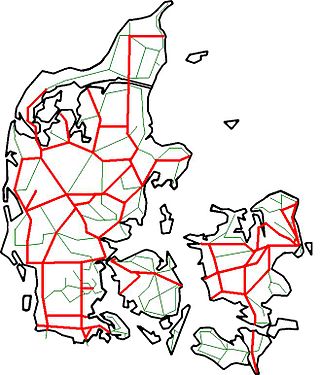
Danish is a North Germanic language from the Indo-European language family spoken by about six million people, principally in and around Denmark. Communities of Danish speakers are also found in Greenland, the Faroe Islands, and the northern German region of Southern Schleswig, where it has minority language status. Minor Danish-speaking communities are also found in Norway, Sweden, the United States, Canada, Brazil, and Argentina.

The Prince's Life Regiment was a Royal Danish Army infantry regiment. The motto of the regiment was "Gloria Finis".

The Jutland Dragoon Regiment is the only regiment of the Royal Danish Army that has an armored (MBT) battalion, and is one of the Danish combat regiments in which soldiers are entitled to wear the black beret of the Armoured corps.

The Battle of Sehested was fought between Danish and Russian-Prussian-British troops at Sehested on 10 December 1813 during the War of the Sixth Coalition. The Danish Auxiliary Corps, which fought on the side of the French defeated the coalition forces commanded by Major General Ludwig von Wallmoden-Gimborn.

The history of rail transport in Denmark began in 1847 with the opening of a railway line between Copenhagen and Roskilde. The Kiel-Altona line in Holstein was completed three years earlier, but the region was later lost to the German Confederation in the Second War of Schleswig.

The Zealand Life Regiment was a Royal Danish Army infantry regiment. On 1 January 2001 it was disbanded and amalgamated into the Guard Hussar Regiment, which was moved from Næstved to Slagelse.

The Danish Life Regiment was an infantry regiment of the Royal Danish Army. On 1 January 2001 it was merged with the Zealand Life Regiment, into the Guard Hussar Regiment.

The Funen Life Regiment was an infantry regiment of the Royal Danish Army. On 1 November 1991 it was merged with the King's Jutlandic Regiment of Foot, into Slesvigske Fodregiment.

The Danish Artillery Regiment is an artillery unit of the Royal Danish Army, which was founded on 1 November 2005 when the two artillery regiments in Denmark, King's Artillery Regiment and Queen's Artillery Regiment were merged. The unit was disbanded in 2014 and revived in 2019.

The Danish language has a number of regional and local dialect varieties. These can be divided into the traditional dialects, which differ from modern Standard Danish in both phonology and grammar, and the Danish accents, which are local varieties of the standard language distinguished mostly by pronunciation and local vocabulary colored by traditional dialects. Traditional dialects are now mostly extinct in Denmark, with only the oldest generations still speaking them.

The Schleswig Regiment of Foot is a Royal Danish Army infantry regiment. On 1 January 2001, the regiment was merged with the Queen's Life Regiment to form the Prince's Life Regiment. In 2018, it was announced that the regiment would be reestablished on 1 January 2019 as a light infantry battalion.

The Falster Foot Regiment was a Royal Danish Army infantry regiment. On 1 August 1976 it was amalgamated into the Danish Life Regiment, where four out of five battalions continued to exist until 1981.

The Battle of Bornhöved or Bornhöft took place on 7 December 1813 between a Swedish cavalry regiment,Mörner's Hussar Regiment later Kronprinsens husarregemente or Crown Prince's Hussar Regiment) under Bror Cederström and Prince Frederik of Hesse's Danish troops reinforced by smaller numbers of Polish cavalry and German infantry. The clash occurred at the small village of Bornhöft in what is now Schleswig-Holstein in northern Germany. The engagement occurred during the War of the Sixth Coalition, part of the Napoleonic Wars, and was one of the last time Swedish and Danish forces met on the battlefield.

The 10th Regiment was a Danish Army infantry regiment. On 1 September 1961 it was merged with 8. Regiment and from 1 November 1961 the new regiment was known as Dronningens Livregiment. The name Feltherrens Fodregiment was never the official name, as the official name was 10. Regiment.

The Marine Regiment was the naval infantry of the Royal Dano-Norwegian Navy, and later an infantry regiment, established in 1672 by Christian IV and based at Glückstadt Naval Station.

The King's Regiment of Foot was a Royal Danish Army infantry regiment. On 1 November 1961, it was amalgamated with the Jutlandic Regiment of Foot, to create the King's Jutlandic Regiment of Foot.

The Queen's Life Regiment was a Royal Danish Army infantry regiment. On 1 January 2001, it was amalgamated with the Prince's Life Regiment.

The King's Jutlandic Regiment of Foot was a Royal Danish Army infantry regiment. On 1 November 1991, it was merged with the Funen Life Regiment, into Schleswig Regiment of Foot.

The Western Regional Command was the overall command of all Royal Danish Army units in Jutland and on Funen. It was split into four military regions, and was responsible for the regional defence. In 1990, the Regional Commands were disbanded and control was collected at the newly created Army Operational Command.





















